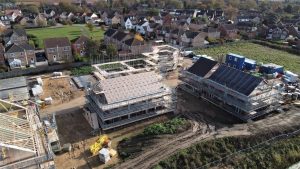The Procure Partnerships Framework continues to support clients with projects to replace non-ACM Cladding Systems and in this blog Robbie Blackhurst (Framework Director) outlines the importance of these schemes and the impact of the Building Safety Fund.
Following the Government’s Budget announcement on 11th March 2020 for a new £1 billion investment scheme to overhaul unsafe non-ACM cladding on high-rise buildings, the Government has now pledged a further £5 billion investment in building safety, including £3.5 billion to fully fund the cost of replacing hazardous cladding for all leaseholders in residential buildings over 6 storeys high in England. The application deadline has been extended to 30th June 2021 to allow more applicants time to prepare and complete their applications for funding.
A new £30 million fund has also been announced by The Ministry of Housing, Communities and Local Government (MHCLG) for building owners to install fire alarms in high-rise buildings currently awaiting remediation. This is set to relieve financial pressure on building owners and tenants who are forced to fund a 24-hour ‘waking watch’ fire security service, costing each tenant on average an extravagant £137 per month.
Building Safety Fund Eligibility Criteria
• Applicable to residential high-rise buildings over 18 metres tall with non-ACM cladding, metal composite or high-pressure laminate cladding systems that do not conform to fire safety standards.
• Public sector registration is accepted from building owners, freeholders, or the body legally responsible for works to be carried out on the building.
• Leaseholders who would otherwise be obliged to pay for the cost of remediation through their service charge.
• Social housing units held in blocks owned in the private sector will be eligible as part of the relevant application for that building.
Full applications must now be made by 30 June 2021, with works to commence on site by 30 September 2021, which is a 6-month extension to the original deadline.
The Importance of the Building Safety Fund
The Grenfell Tower tragedy is a stark reminder of the importance of professional health and safety standards and compliancy for properties and building materials. On 14th June 2017, an electrical fire broke out inside an apartment of the 24-storey block of flats in North Kensington, West London. The fire spread quickly, exacerbated by dangerous and highly flammable exterior cladding, resulting in 72 deaths and 74 serious injuries. Marked in history as the worst UK residential fire since WW2, it forced the Government to conduct urgent fire safety tests on similar high-rise cladding systems and carry out an independent review of building regulations and fire safety standards. Part B of the current Building Regulations advises ‘the external walls of the building shall adequately resist the spread of fire over the walls’ and should be classified to BR 135 Fire Performance of External Thermal Insulation for Walls of Multistorey Buildings. The Royal Institution of Chartered Surveyors (RICS) recommends all high-risk buildings, residential tower blocks and buildings more than 18m in height, care homes, hotels, student accommodation and hospitals, should conduct a Fire Risk Assessment (FRA) annually. In a determined effort to bring an end to unsafe cladding systems, the Government funding is part of a 5-pronged plan of intervention to provide reassurance to home-owners and renew confidence in the housing market.
A Boost for The Housing Market
The Housing Secretary Robert Jenrick announced the funding to remove non-ACM cladding that does not meet the required fire regulations as the first step of a five-step plan. The second step to fully fund the remediation works to replace the cladding systems comes as a welcomed relief to many leaseholders and tenants across the country as the scheme will remove the significant risk to health and safety and give peace of mind to residents that their home is a safe environment to live in. Home Office fire and rescue statistics demonstrate buildings between 18-30 metres are four times more likely to suffer a fire with fatalities or serious casualties than any other type of apartment complex. The scheme will guarantee leaseholders that any payments made towards the removal of unsound cladding will be less than £50 a month, finally providing some reassurance, security, and financial relief. Mortgage lenders can also be confident that where cladding removal is required, properties will have a value that is worth lending against.
The third step is a positive move to reduce the requirement for an EWS1 Form. Thanks to an agreement reached on 21st November 2020 between the Government, RICS, UK Finance and the Building Societies Association (BSA), owners of flats in buildings without cladding will no longer need an EWS1 form; preventing leaseholders from facing delays and eliminating the stale mate affecting hundreds of thousands of homes; once again allowing them to be sold, bought, or re-mortgaged.
The Government’s fourth step is a world-class new safety regime to ensure a tragedy like Grenfell never happens again, making homes safer for the future.
‘Gateway 2’ Developer Levy
The final step of the plan highlights that taxpayers should not carry the financial burden of remedying the failures of building safety. Therefore, a Gateway 2 levy will be introduced and apply when developers request permission to develop specific high-rise buildings in England.
A new tax will also be introduced for the UK residential property development sector, raising £2 billion over a ten-year period to help pay for cladding remediation costs. The tax will ensure that the largest property developers make a fair contribution to the remediation programme, reflecting the return on investment realised from restoring confidence to the UK housing market and driving up standards for the future.
Contractor Interest & Capacity to Deliver the Re-Cladding Programme
In a survey conducted by NACF in June 2020, including responses from the 9 largest contractors in the UK, 80% confirmed their interest in the re-cladding programme and would have the capacity to deliver the works. 763 suppliers were identified across 7 trades nationwide, namely scaffolding, mast climbers, cladding contractors, cladding manufacturers, windows and fire door suppliers, fire detection and security services. 56% of contractors advised they preferred the Design & Build procurement route for the scheme, with the major contractors favouring the ‘two-stage’ tender call-off method through a procurement framework; as it provides sufficient opportunity for surveys and investigations to be carried out, shares the risk, and defines risk in detail. A procurement framework will also ensure the supply chain has previous high-rise cladding experience. This scheme is a real opportunity for the construction industry to show how it adapts to make our communities safer places to live.
Click Here To Download a Procure Partnerships Framework User Guide

Robbie Blackhurst is the Founder and Director of Black Capital Group, the holding company that powers Advance Social Value, Compliance Chain, Procure Partnerships Framework and Strategic Resourcing. Robbie is a member of the Chartered Institute of Builders, is MCIPS certified and has an undergraduate degree in Aviation and Aerospace, a postgraduate degree in Construction Project Management, and a Master’s in Business (MBA).



